Related Posts:
- 10 Big Books I Have Read & Loved
- 6 Big Books I Keep Meaning to Reread
- 6 Big Books on My Reading List
- 2 Big Books That Disappointed Me
![]()
Since I read a lot more fiction than nonfiction, it’s not surprising that all of my earlier Big Books lists have included only novels. However, in looking over my reading lists of the past several years, I discovered five nonfiction works that qualify as Big Books.
I thought I’d find more, but many of the potential candidates I looked at checked in at around 450 pages. I even found one of 497 pages that I was tempted to include, but I finally decided that, since “500 pages or more” is my working definition of the term Big Book, I should stick to that definition here as well.
Truman by David McCullough
Hardcover, 1116 pages
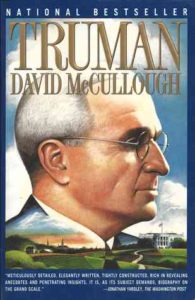 How could I not love a man who taught himself Latin while driving a horse-drawn plow back and forth across the fields of his family’s farm?
How could I not love a man who taught himself Latin while driving a horse-drawn plow back and forth across the fields of his family’s farm?
The best writers of creative nonfiction use novelistic techniques to develop characters, create settings, interject background material, and pace action in service to telling a compelling story. David McCullough is one of those writers. I’ve loved every one of his books that I’ve read, but he is at his outstanding best in this biography of the simple man from Missouri who lead the United States through one of its most crucial periods. Here’s how Goodreads describes the subject of this biography:
The last president to serve as a living link between the nineteenth and the twentieth centuries, Truman’s story spans the raw world of the Missouri frontier, World War I, the powerful Pendergast machine of Kansas City, the legendary Whistle-Stop Campaign of 1948, and the decisions to drop the atomic bomb, confront Stalin at Potsdam, send troops to Korea, and fire General MacArthur.
Truman is both an outstanding historical document and a literary masterpiece.
Lindbergh by A. Scott Berg
Hardcover, 640 pages
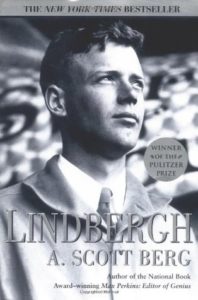 Like McCullough, Berg tells a masterful story of his subject’s life.
Like McCullough, Berg tells a masterful story of his subject’s life.
However, Charles Lindbergh isn’t as easy a subject to portray as Harry Truman. The same qualities that made Lindbergh a brilliant, dedicated, and persevering achiever also made him difficult to live with. For example, when he tried to play with his children, he developed games with such arduous and fussy rules that they were not games at all, but rather overwhelming tasks that the children dreaded and resented.
Nonetheless, Berg compellingly portrays what Goodreads calls “the life of one of the nation’s most legendary, controversial, and enigmatic figures.”
Unbroken: A World War II Story of Survival, Resilience, and Redemption by Laura Hillenbrand
Paperback, 500 pages
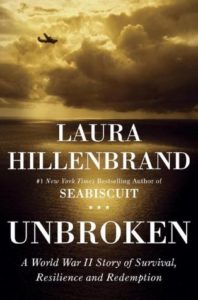 Here’s yet another brilliant biography compellingly told. Laura Hillenbrand, whose earlier book Seabiscuit does not quite qualify as a Big Book, recounts the life of Louis Zamperini.
Here’s yet another brilliant biography compellingly told. Laura Hillenbrand, whose earlier book Seabiscuit does not quite qualify as a Big Book, recounts the life of Louis Zamperini.
As a boy, Zamperini was a delinquent whose activities included breaking into houses, getting into fights, and running away from home to ride the freight rails. As a teenager, he channeled his rebellion into running and became successful enough to participate in the 1936 Berlin Olympics, where he placed eighth in the 5000 m race.
When World War II arrived, Zamperini went off to fight. In 1943 he was the bombardier on a plane that crashed into the Pacific Ocean. He managed to survive in thousands of miles of open ocean by clinging to a tiny life raft. Later he bacame a prisoner of war, where he inspired his fellow prisoners with his refusal to give in to the brutal conditions and torture imposed by their captors.
Zamperini died in 2014 at the age of 97.
Girls Like Us: Carole King, Joni Mitchell, Carly Simon – and the Journey of a Generation by Sheila Weller
Hardcover, 584 pages
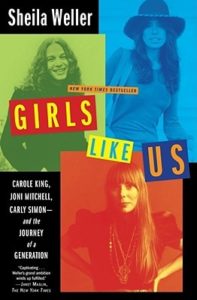 I grew up with the music of Carole King, Joni Mitchell, and Carly Simon. Although—or perhaps because—I never knew much about their lives, I was drawn to Weller’s book.
I grew up with the music of Carole King, Joni Mitchell, and Carly Simon. Although—or perhaps because—I never knew much about their lives, I was drawn to Weller’s book.
Here’s Goodreads’ description of the book’s content:
Carole King, Joni Mitchell, and Carly Simon remain among the most enduring and important women in popular music. Each woman is distinct. Carole King is the product of outer-borough, middle-class New York City; Joni Mitchell is a granddaughter of Canadian farmers; and Carly Simon is a child of the Manhattan intellectual upper crust. They collectively represent, in their lives and their songs, a great swath of American girls who came of age in the late 1960s. Their stories trace the arc of the now mythic sixties generation – female version – but in a bracingly specific and deeply recalled way, far from cliche. The history of the women of that generation has never been written – until now, through their resonant lives and emblematic songs.
This eminently readable book helped me understand that pivotol decade, the 1960s, much better than I had while living through it.
The Feminine Mystique by Betty Friedan
Paperback, 592 pages
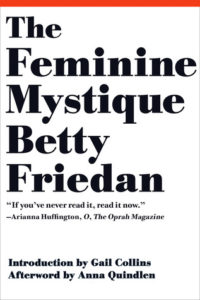 Published in 1963, this ground-breaking work described “the problem that has no name.” Without knowing exactly what to call it, Friedan had discovered that smothered feeling women felt because of unquestioned social beliefs that urged them to be content with home and family, and of institutions of higher learning that minimized their intellectual potential by turning homemaking into a glorified academic discipline.
Published in 1963, this ground-breaking work described “the problem that has no name.” Without knowing exactly what to call it, Friedan had discovered that smothered feeling women felt because of unquestioned social beliefs that urged them to be content with home and family, and of institutions of higher learning that minimized their intellectual potential by turning homemaking into a glorified academic discipline.
Writing in a time when the average woman first married in her teens and 60 percent of women students dropped out of college to marry, Betty Friedan captured the frustrations and thwarted ambitions of a generation and showed women how they could reclaim their lives.
Source: Goodreads
I read this book back in college in the late 1960s, but I appreciated it much more when I reread it just a few years ago.
© 2016 by Mary Daniels Brown

